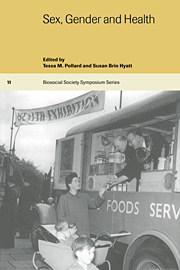Book contents
- Frontmatter
- Contents
- List of contributors
- Preface
- 1 Sex, gender and health: integrating biological and social perspectives
- 2 Parental manipulation of postnatal survival and well-being: are parental sex preferences adaptive?
- 3 Gender bias in South Asia: effects on child growth and nutritional status
- 4 Sex, gender and cardiovascular disease
- 5 Social meanings and sexual bodies: gender, sexuality and barriers to women's health care
- 6 Poverty and the medicalisation of motherhood
- 7 The vanishing woman: gender and population health
- 8 Agency, opposition and resistance: a systemic approach to psychological illness in sub-dominant groups
- Glossary
- Index
4 - Sex, gender and cardiovascular disease
Published online by Cambridge University Press: 07 December 2009
- Frontmatter
- Contents
- List of contributors
- Preface
- 1 Sex, gender and health: integrating biological and social perspectives
- 2 Parental manipulation of postnatal survival and well-being: are parental sex preferences adaptive?
- 3 Gender bias in South Asia: effects on child growth and nutritional status
- 4 Sex, gender and cardiovascular disease
- 5 Social meanings and sexual bodies: gender, sexuality and barriers to women's health care
- 6 Poverty and the medicalisation of motherhood
- 7 The vanishing woman: gender and population health
- 8 Agency, opposition and resistance: a systemic approach to psychological illness in sub-dominant groups
- Glossary
- Index
Summary
Cardiovascular disease (CVD) is the leading cause of death for women in many industrialised countries. Because more men than women die from CVD (taken here to mean the most important heart diseases, cerebrovascular disease or stroke, and hypertension), however, it is generally identified as a male disease (Brezinka and Padmos 1994, and see Chapter 1). Research in the United States has shown that most women and many doctors are not aware of its importance for women (Reis et al. 1997). As a consequence, women were for a long time excluded from clinical trials and epidemiological studies and the results of these investigations were simply extended and applied to women. It is now acknowledged that men and women have differential exposure to risk factors and that male and female bodies respond differently to some of the same risk factors. For instance, the presence of high levels of oestrogen in the bodies of pre-menopausal women is thought to offer them some protection against the development of CVD. It is important to explore these differences rather than make assumptions about women's risks based on data collected from men.
In this chapter, I attempt to demonstrate how gender and sex differences interact to affect the prevalence of CVD in men and women, focusing on the role of oestrogen. I show how modern lifestyles affect levels of oestrogen and how oestrogen may influence women's responses to risk factors for CVD in modern environments.
- Type
- Chapter
- Information
- Sex, Gender and Health , pp. 53 - 74Publisher: Cambridge University PressPrint publication year: 1999
- 6
- Cited by

